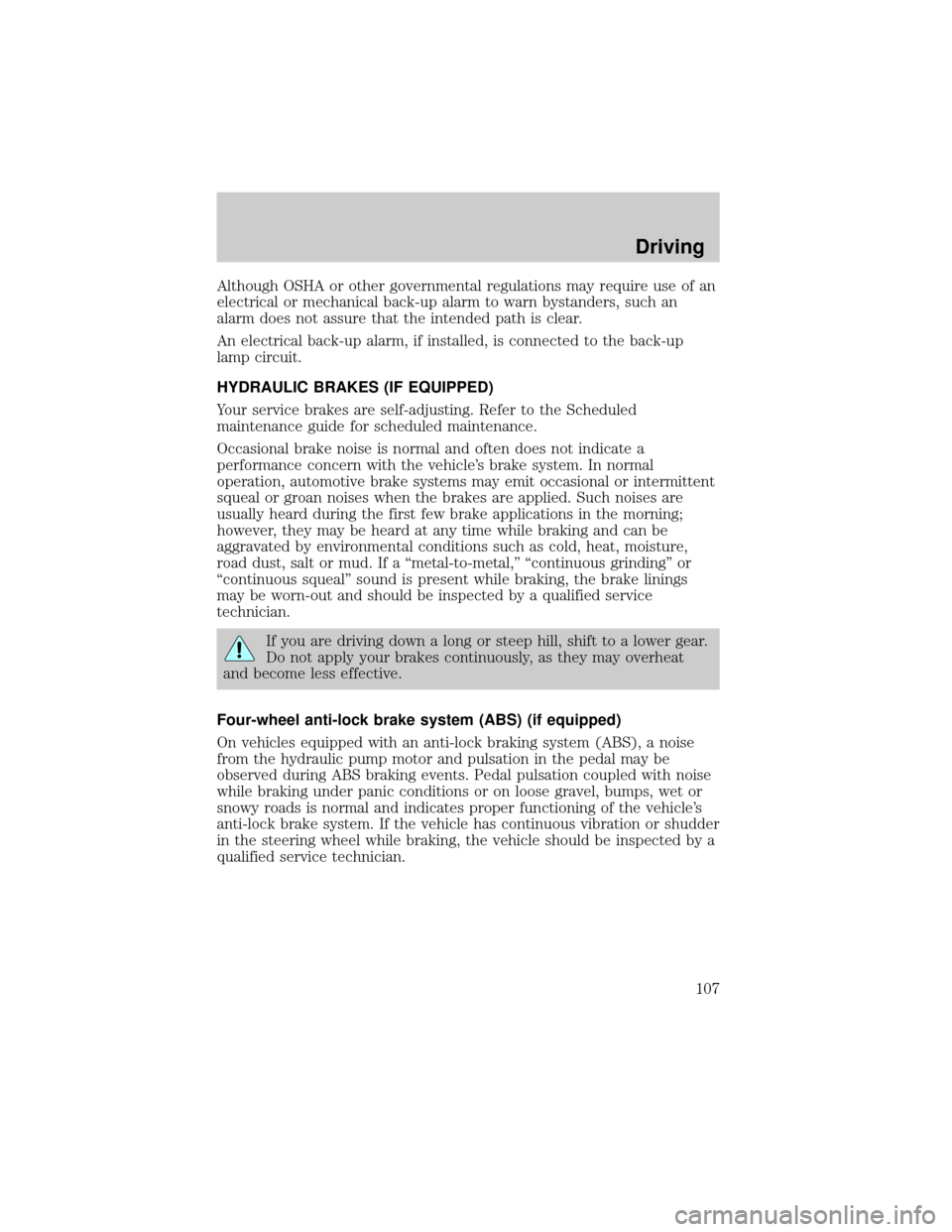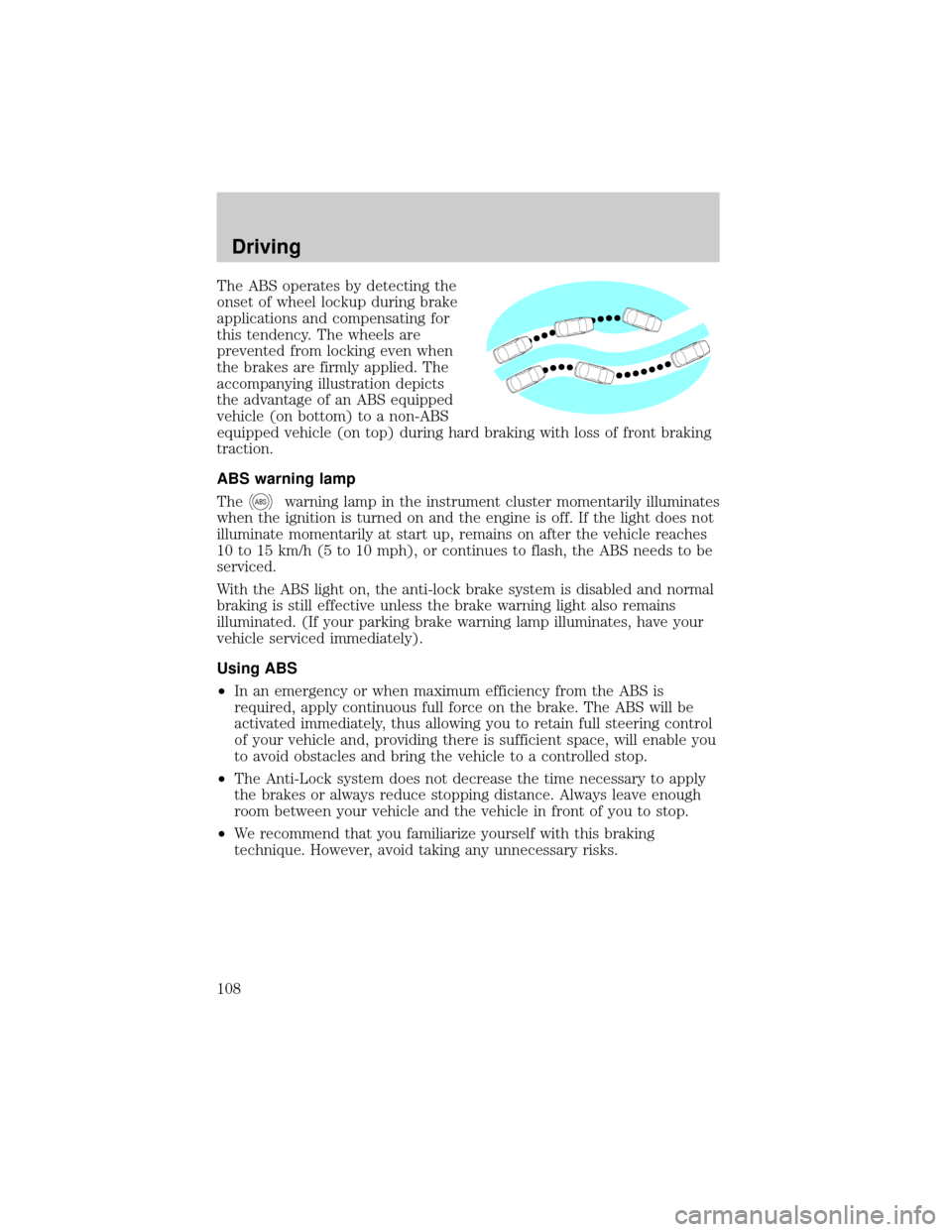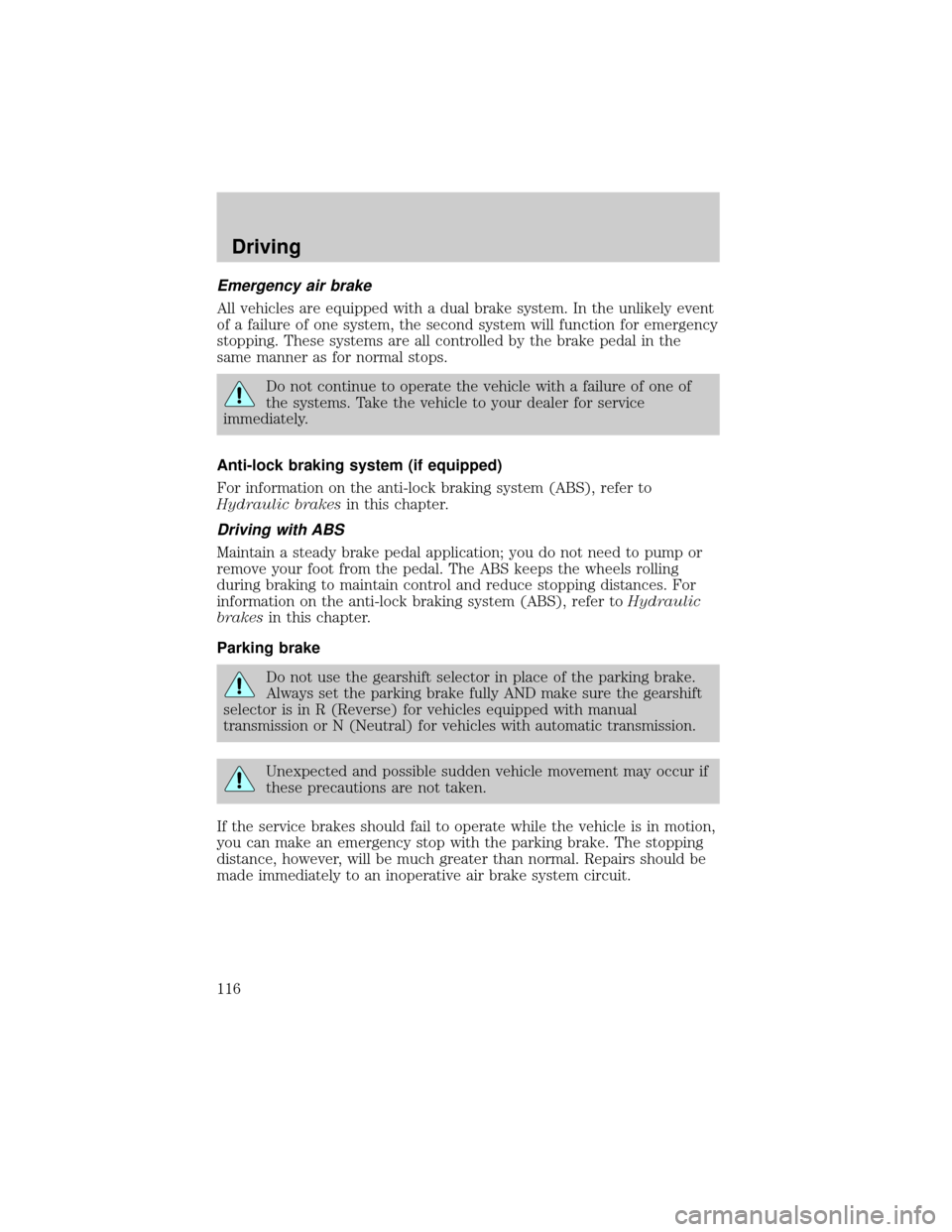Page 8 of 240
0 30
90 60
150
AIR
PRESSURE
PSIP
0
000000000
MPH20km/h
406080
100
120
140
160
010 20304050
60
70
80
90
100
P
ABS TRAILER
BRAKE
ABS
TRANS
TEMP
+ -LEF
HRPM1000 DIESEL FUEL ONLYX012
3
4
PRN 218C 18
H
D
!BRAKE
BRAKE
Headlamp control
(pg. 21) Panel dimmer control
(pg. 21)Parking brake*
(hydraulic brake system)
(pg. 107)Instrument cluster
(pg. 10)
Turn signal and
wiper/washer control
(pg. 65)
Instrumentation
8
Page 13 of 240
High beams
Illuminates when the high beam
headlamps are turned on.
Anti-lock brake system (ABS)
Momentarily illuminates when the
ignition is turned to the ON position
and the engine is off. If the light
remains on after the vehicle is
started, continues to flash or fails to
illuminate, have the system serviced immediately. With the ABS light on,
the anti-lock brake system is disabled and normal braking is still effective
unless the brake warning light also remains illuminated.
Wait to start
Indicates the air intake heater is in
operation and special starting
procedures are required. Refer to
theStartingchapter.
If equipped with an air intake heater, DO NOT use ether or any
other starting fluids. The use of starting fluids (ether) in an
engine equipped with an air intake heater could result in damage
and/or personal injury.
ABS
WAIT
TO
START
Instrumentation
13
Page 107 of 240

Although OSHA or other governmental regulations may require use of an
electrical or mechanical back-up alarm to warn bystanders, such an
alarm does not assure that the intended path is clear.
An electrical back-up alarm, if installed, is connected to the back-up
lamp circuit.
HYDRAULIC BRAKES (IF EQUIPPED)
Your service brakes are self-adjusting. Refer to the Scheduled
maintenance guide for scheduled maintenance.
Occasional brake noise is normal and often does not indicate a
performance concern with the vehicle's brake system. In normal
operation, automotive brake systems may emit occasional or intermittent
squeal or groan noises when the brakes are applied. Such noises are
usually heard during the first few brake applications in the morning;
however, they may be heard at any time while braking and can be
aggravated by environmental conditions such as cold, heat, moisture,
road dust, salt or mud. If a ªmetal-to-metal,º ªcontinuous grindingº or
ªcontinuous squealº sound is present while braking, the brake linings
may be worn-out and should be inspected by a qualified service
technician.
If you are driving down a long or steep hill, shift to a lower gear.
Do not apply your brakes continuously, as they may overheat
and become less effective.
Four-wheel anti-lock brake system (ABS) (if equipped)
On vehicles equipped with an anti-lock braking system (ABS), a noise
from the hydraulic pump motor and pulsation in the pedal may be
observed during ABS braking events. Pedal pulsation coupled with noise
while braking under panic conditions or on loose gravel, bumps, wet or
snowy roads is normal and indicates proper functioning of the vehicle's
anti-lock brake system. If the vehicle has continuous vibration or shudder
in the steering wheel while braking, the vehicle should be inspected by a
qualified service technician.
Driving
107
Page 108 of 240

The ABS operates by detecting the
onset of wheel lockup during brake
applications and compensating for
this tendency. The wheels are
prevented from locking even when
the brakes are firmly applied. The
accompanying illustration depicts
the advantage of an ABS equipped
vehicle (on bottom) to a non-ABS
equipped vehicle (on top) during hard braking with loss of front braking
traction.
ABS warning lamp
The
ABSwarning lamp in the instrument cluster momentarily illuminates
when the ignition is turned on and the engine is off. If the light does not
illuminate momentarily at start up, remains on after the vehicle reaches
10 to 15 km/h (5 to 10 mph), or continues to flash, the ABS needs to be
serviced.
With the ABS light on, the anti-lock brake system is disabled and normal
braking is still effective unless the brake warning light also remains
illuminated. (If your parking brake warning lamp illuminates, have your
vehicle serviced immediately).
Using ABS
²In an emergency or when maximum efficiency from the ABS is
required, apply continuous full force on the brake. The ABS will be
activated immediately, thus allowing you to retain full steering control
of your vehicle and, providing there is sufficient space, will enable you
to avoid obstacles and bring the vehicle to a controlled stop.
²The Anti-Lock system does not decrease the time necessary to apply
the brakes or always reduce stopping distance. Always leave enough
room between your vehicle and the vehicle in front of you to stop.
²We recommend that you familiarize yourself with this braking
technique. However, avoid taking any unnecessary risks.
Driving
108
Page 116 of 240

Emergency air brake
All vehicles are equipped with a dual brake system. In the unlikely event
of a failure of one system, the second system will function for emergency
stopping. These systems are all controlled by the brake pedal in the
same manner as for normal stops.
Do not continue to operate the vehicle with a failure of one of
the systems. Take the vehicle to your dealer for service
immediately.
Anti-lock braking system (if equipped)
For information on the anti-lock braking system (ABS), refer to
Hydraulic brakesin this chapter.
Driving with ABS
Maintain a steady brake pedal application; you do not need to pump or
remove your foot from the pedal. The ABS keeps the wheels rolling
during braking to maintain control and reduce stopping distances. For
information on the anti-lock braking system (ABS), refer toHydraulic
brakesin this chapter.
Parking brake
Do not use the gearshift selector in place of the parking brake.
Always set the parking brake fully AND make sure the gearshift
selector is in R (Reverse) for vehicles equipped with manual
transmission or N (Neutral) for vehicles with automatic transmission.
Unexpected and possible sudden vehicle movement may occur if
these precautions are not taken.
If the service brakes should fail to operate while the vehicle is in motion,
you can make an emergency stop with the parking brake. The stopping
distance, however, will be much greater than normal. Repairs should be
made immediately to an inoperative air brake system circuit.
Driving
116
Page 147 of 240
Fuse/Relay
LocationFuse Amp
RatingPassenger Compartment Fuse
Panel Description
23 10A Electronic Flasher
24 15A Vacuum Pump, Air Dryer, ABS,
Fuel Heater Relay
25 10A Blower Motor Relay
26 10A Right Low Beam Headlamp
27 Ð Not Used
28 10A Left Low Beam Headlamp
29 10A Cluster, GEM, 7.3L Power Stroke
PCM (clutch switch input), APCM
(7.3L Power Stroke only),
Overhead Console (SuperCrewzer
only), Keyless Entry Module
(SuperCrewzer only), Traxx
(Fuel) Module (SuperCrewzer
only)
30 30A 7.3L Power Stroke PCM Diode,
7.3L Power Stroke Fuel Heater
31 15A Allison MD Transmission, Neutral
Start Relay and PCM (7.3L Power
Stroke only)
Relay 1 Ð Interior Lamps
Relay 2 Ð Not Used
Relay 3 Ð Horn
Relay 4 Ð One Touch Down
Relay 5 Ð Not Used
Roadside emergencies
147
Page 149 of 240
Fuse/Relay
LocationFuse Amp
RatingPower Distribution Box
Description
5 15A* Air Intake Heater Relay (CAT),
Cummins PCM
6 20A* CAT PCM, Cummins PCM
7 15A* Stop Lamps
8 25A* C AT Fuel Heater
9 30A* Trailer Hook Up lamps
(SuperCrewzer only)
10 15A* Shift Modulator (Allison AT trans
only)
11 20A* Allison MD Trans, Allison
2000/2400 Trans
12 10A* Keyless Entry Module
(SuperCrewzer only)
13 10A* Park Brake Adjustment Module
(SuperCrewzer only)
14 Ð Not Used
15 7.5A* Body Builder Prep (Hydraulic
Vehicles Only)
16 10A* Allison 2000/2400 Trans
17 5A* Radio (SuperCrewzer only)
18 Ð Not Used
19 Ð Not Used
20 Ð Not Used
21 10A* GEM (Hydraulic Vehicles Only)
22 Ð Not Used
23 Ð Not Used
24 Ð Not Used
101 40A** ABS (Air Only)
102 20A** Body Builder Prep Run Feed
103 50A** Ignition Switch (JB fuses 8, 9, 11,
19, 20, 22, 23, 24, 25, 29, 30, 31)
Roadside emergencies
149
Page 150 of 240
Fuse/Relay
LocationFuse Amp
RatingPower Distribution Box
Description
104 20A** Power Point
105 20A** Power Door Locks
106 30A** Headlamps
107 50A** Junction Box Battery Feed (fuses
1, 2, 3, 4, 12, 13, 14, 15)
108 40A** Cummins Fuel Heater
109 40A** Power Windows
110 30A** Power Seats (SuperCrewzer only)
111 30A** Body Builder Prep
112 40A** Blower Motor
113 30A** Heated Seats (SuperCrewzer
only)
114 30A** E-Brake (SuperCrewzer only)
115 40A** Ignition Switch (JB fuses 5, 8, 9,
11, 21)
116 30A** Body Builder Prep
117 20A** 7.3L Power Stroke PCM
118 30A** IDM (7.3L Power Stroke only)
119
12060A** Hydraulic ABS, Air Brake Trailer
Tow Fuse Block
121
12260A** Hydromax Motor, Air Brake
Trailer Tow Fuse Block
201 Ð Washer Pump Relay
202 Ð Wiper Speed Relay
203 Ð Wiper Run/Park Relay
204 Ð 7.3L Power Stroke Neutral Start
Relay, Stoplamp Relay (CAT and
Cummins only)
205 Ð Right Hand Stop/Turn Relay
206 Ð Left Hand Stop/Turn Relay
Roadside emergencies
150